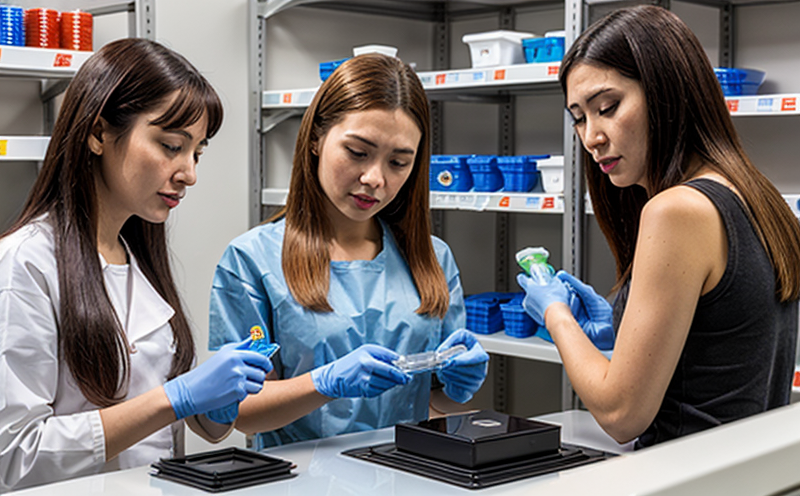EPA 3050 Heavy Metals Analysis Testing of Consumer Plastics
The Environmental Protection Agency's (EPA) Standard Sampling and Sample Preparation Procedure for the Determination of Metals in Soils, Sludges, Sediments, and Other Media Used or Produced by Municipal Wastewater Treatment Plants involves a specific section dedicated to consumer plastics. This service focuses on EPA 3050B, which is an essential part of this process designed specifically for the analysis of heavy metals within consumer plastics.
Consumer plastics have become ubiquitous in modern society, but they also pose potential risks if not handled and managed properly. Heavy metal contamination can lead to adverse health effects and environmental degradation. Therefore, rigorous testing and quality control measures are crucial throughout the lifecycle of these products. The EPA 3050B method provides a standardized approach for extracting metals from consumer plastics, ensuring accurate and consistent results.
Our laboratory adheres strictly to this methodology, using state-of-the-art equipment and experienced personnel to deliver reliable test results. The procedure involves several key steps: sampling, digestion of the plastic matrix, and finally, analysis via either atomic absorption spectroscopy (AAS) or inductively coupled plasma mass spectrometry (ICP-MS). Each step is critical for obtaining accurate measurements.
The importance of this testing cannot be overstated. It helps manufacturers ensure compliance with regulatory standards such as the European Union's Restriction on Hazardous Substances Directive (RoHS), which limits levels of certain hazardous substances in electrical and electronic equipment, including plastics used in these products. By adhering to EPA 3050B, companies can demonstrate their commitment to environmental stewardship and public health.
Our comprehensive testing service ensures that every aspect of the process is meticulously followed, from initial sample collection through final analysis. This attention to detail guarantees accurate results that meet both internal quality control requirements and external regulatory demands.
Understanding the importance of this test for consumer plastics, we have compiled some key points about EPA 3050B:
| Key Point | Description |
|---|---|
| Sampling Protocol | Defined procedures to collect representative samples from various types of consumer plastics. |
| Digestion Methodology | Chemical digestion techniques used to break down the plastic matrix for metal extraction. |
| Analytical Techniques | Both AAS and ICP-MS methods are employed for precise detection of heavy metals. |
| Data Interpretation | Expert interpretation of results against relevant regulatory limits. |
The significance of this testing extends beyond mere compliance. It plays a vital role in the development and lifecycle management of consumer plastics, ensuring that products remain safe for use while minimizing environmental impact. By implementing EPA 3050B testing early in the design process, manufacturers can identify potential issues before they become costly problems down the line.
Our laboratory is committed to providing accurate, reliable, and timely results using this standardized method. We understand that timely delivery of these reports is crucial for informed decision-making within your organization. Our team works closely with clients throughout each stage of the testing process to ensure you receive the information needed to make well-informed choices about product development and quality assurance.
For more detailed insights into how EPA 3050B applies to consumer plastics, please refer to the following sections:
Applied Standards
| Standard | Description |
|---|---|
| EPA Method 3050B | Procedure for extracting metals from various media, including consumer plastics. |
| RoHS Directive | European regulation limiting the use of certain hazardous substances in electrical and electronic products. |
| ISO 17025 | International standard specifying requirements for the competence of testing and calibration laboratories. |
The EPA Method 3050B is central to our service offering. It provides a standardized approach to extracting metals from consumer plastics, ensuring accurate and consistent results across different laboratories. Compliance with this method ensures that your organization meets regulatory requirements set by authorities like the RoHS Directive.
Our laboratory operates under ISO 17025 certification, which guarantees high standards of quality in our testing processes. This certification underscores our commitment to accuracy, reliability, and consistency in all aspects of our work.
Environmental and Sustainability Contributions
The analysis of heavy metals in consumer plastics contributes significantly to environmental protection efforts. Heavy metal contamination can lead to soil and water pollution, affecting ecosystems and human health. By identifying and controlling the presence of these contaminants early on, our testing service helps mitigate such risks.
Our laboratory plays a crucial role in supporting sustainable practices within your organization. We work closely with clients to interpret results against relevant regulatory limits and provide recommendations for reducing environmental impact. This includes advising on material selection, production processes, and end-of-life disposal methods that minimize heavy metal content.
The knowledge gained from our testing can also inform product design improvements aimed at reducing overall environmental footprint. By incorporating sustainable practices into everyday operations, organizations contribute positively to global efforts towards cleaner environments.
Use Cases and Application Examples
| Use Case | Description |
|---|---|
| New Product Development | Evaluating potential new materials before production to ensure compliance with regulatory standards. |
| Ongoing Quality Assurance | Monitoring existing products for adherence to established quality control measures over time. |
| Lifecycle Management | Assessing the environmental impact of waste streams throughout their lifecycle. |
Our testing service supports a range of applications across various industries. For instance, during new product development, manufacturers can use EPA 3050B analysis to evaluate potential new materials before committing resources to full-scale production runs. This helps avoid costly mistakes and ensures that all components meet necessary safety standards.
In ongoing quality assurance programs, periodic testing using this method allows companies to monitor their products continuously for any deviations from expected levels of heavy metals. Early detection enables swift corrective actions if issues arise.
For lifecycle management initiatives, EPA 3050B analysis can play an important role in assessing the environmental impact of waste streams throughout various stages—from manufacturing through disposal or recycling. Understanding these impacts helps guide strategies for reducing overall negative effects on nature.





